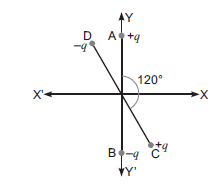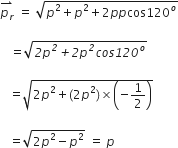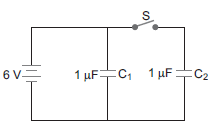 Short Answer Type
Short Answer TypeA point charge Q is placed at point O as shown in the figure. Is the potential difference VA –VB positive, negative, or zero, if Q is (i) positive (ii) negative? 
A plane electromagnetic wave travels in vacuum along z-direction. What can you say about the direction of electric and magnetic field vectors?
A resistance R is connected across a cell of emf  and internal resistance r. A potentiometer now measures the potential difference between the terminals of the cell as V. Write the expression for 'r' in terms of
and internal resistance r. A potentiometer now measures the potential difference between the terminals of the cell as V. Write the expression for 'r' in terms of  , V and R.
, V and R.
The permeability of a magnetic material is 0.9983. Name the type of magnetic materials it represents.
Two uniformly large parallel thin plates having charge densities + and –
and – are kept in the X-Z plane at a distance 'd' apart. Sketch an equipotential surface due to electric field between the plates. If a particle of mass m and charge '-q' remains stationary between the plates, what is the magnitude and direction of this field?
are kept in the X-Z plane at a distance 'd' apart. Sketch an equipotential surface due to electric field between the plates. If a particle of mass m and charge '-q' remains stationary between the plates, what is the magnitude and direction of this field?
Two small identical electrical dipoles AB and CD, each of dipole moment 'p' are kept at an angle of 120o as shown in the figure. What is the resultant dipole moment of this combination? If this system is subjected to electric field ( ) directed along + X direction, what will be the magnitude and direction of the torque acting on this?
) directed along + X direction, what will be the magnitude and direction of the torque acting on this? 
Given, AB and CD are dipoles kept at an angle of 120o to each other.
Resultant magnetic dipole moment is given by, 
Resultant magnetic dipole makes an angle 60o with Y-axis or 30o with x-axis.
Now, torque is given by, 
Direction of torque is along negative Z-direction.
A magnetic needle free to rotate in a vertical plane parallel to the magnetic meridian has its north tip down at 60° with the horizontal. The horizontal component of the earth's magnetic field at the place is known to be 0.4 G. Determine the magnitude of the earth's magnetic field at the place.
Figure shows two identical capacitors, C1 and C2, each of 1 μF capacitance connected to a battery of 6 V. Initially switch 'S' is closed. After sometime 'S' is left open and dielectric slabs of dielectric constant K = 3 are inserted to fill completely the space between the plates of the two capacitors. How will the (i) charge and (ii) potential difference between the plates of the capacitors be affected after the slabs are inserted?

How are infrared waves produced? Why are these referred to as 'heat waves’? Write their one important use.
